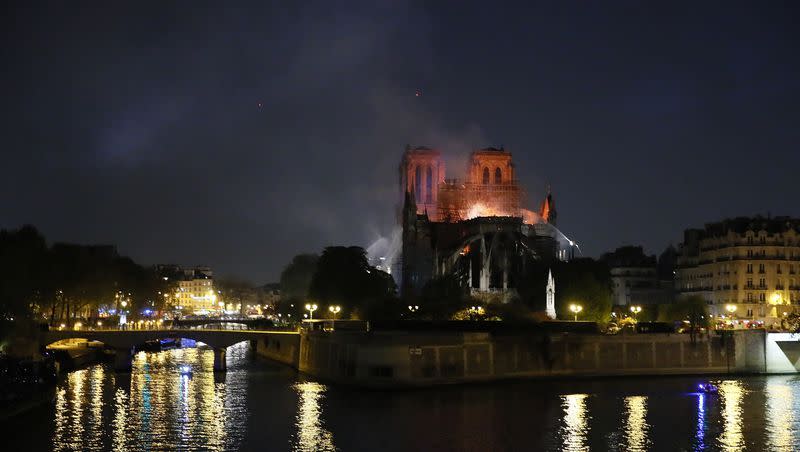Restoring the Notre Dame cathedral — how carpenters are approaching the monumental task

It’s been a little over four years since Notre Dame, a medieval Catholic cathedral in Paris, caught fire.
The fire started in the early evening on April 15, 2019, according to Friends of Notre-Dame Paris. And while firefighters were able to control the fire by the next morning, the roof and spire had burned, and the cathedral — which was undergoing restoration at the time — was damaged.
Roughly 13 million people visit the French Gothic-style cathedral annually, according to CNN. The famous religious landmark can hold over 6,000 people inside and is known for distinctive features like an 8,000-pipe organ and stained glass windows.
“It’s awful to see such a symbol disappearing in front of you,” Thibaud Binétruy, who saw smoke in the cathedral when he was walking home on the night of the fire, told CNN. “It’s been there for so many years and in a few minutes half of it disappears.”
Related
“Like all of my fellow citizens, I am sad to see this part of us burn tonight,” French President Emmanuel Macron said that night, per ABC News. Later, Macron said it was “part of our French destiny” to rebuild and restore the cathedral.
So after the fire subsided, restoration efforts began. Here’s the latest on the restoration process — and when it’s expected to be completed.
Restoring the Notre Dame cathedral
Workers have started to rebuild Notre Dame’s roof. Reconstruction had to pause in 2020 due to the COVID-19 pandemic, per USA Today. The pause lasted for three months.
Currently, reconstruction is going steadily for the cathedral, and carpenters are working on rebuilding the charpente — the framework — Eleanor Beardsley reported for NPR. The completion goal for the entire restoration project is the end of 2024.
Carpenters who are working on rebuilding and restoring the cathedral’s roof are using traditional techniques, per NPR. Even though the framework of the roof won’t be visible, these carpenters are still forgoing modern conveniences like electric saws and nails. They’re also using wood from a local forest to complete the project.
“A cathedral is a structural ensemble that’s very complex, and as soon as you change one little thing, one parameter, it impacts everywhere else in the cathedral,” the head architect, Rémi Fromont, told NPR. “So reconstructing it exactly the same way is also a precaution. It worked very well for 800 years. So we know if we build it back the same way we won’t risk damaging the cathedral by trying something new.”
In a report for “60 Minutes,” General Jean-Louis Georgelin told CBS’ Bill Whitaker that “tons of rubble had to be removed, paintings and stained glass windows were taken away for restoration, and twisted steel scaffolding erected for ongoing restoration work had to be dismantled.”
As part of the restoration work, sculptors are recreating what was lost in the fire.
“We try to remake things identically. But we are also trying to understand the intention of the original sculptors, so we look at the traces left by their tools,” Danae Leblond, one of the sculptors, told CBS News.
A brief history of the Notre Dame cathedral
Construction on the cathedral started in 1163, during the reign of King Louis VII, according to the cathedral’s website. It took just shy of 200 years for the cathedral to be completed — construction was finished in 1345.
Pope Alexander III laid the foundation stone, per Britannica. The idea for the cathedral began with Maurice de Sully, who was the bishop of Paris. He thought of building a large cathedral on top of two basilicas that had been ruined.
The cathedral has been part of several historical moments since its creation, such as the crowing of King Henry VI of England, per National Catholic Register. The cathedral suffered damage during the French Revolution, but Napoleon — who in 1804 was crowned emperor inside Notre Dame — saved the building from complete destruction.
The damaged cathedral remained until an effort was undertaken in the 19th century to restore the cathedral.
One of the driving forces behind the 1844 restoration effort of the Notre Dame cathedral came in the form of Victor Hugo’s “The Hunchback of Notre Dame,” according to the cathedral’s website. At the time of the book’s publication, the cathedral was damaged and the book’s popularity contributed to the king’s decision to order a restoration in 1844.
One of the signature features of the cathedral — the spire — was damaged and removed in the 18th century, per BBC. As part of mid-19th century efforts to restore the cathedral, architect Eugène Viollet-le-Duc designed a spire that was added to the cathedral. The restoration efforts for the spire — which was burned during the 2019 fire — will be inspired by Viollet-le-Duc’s design.

